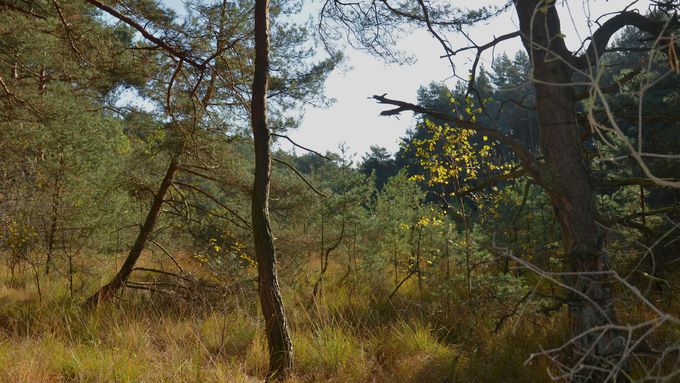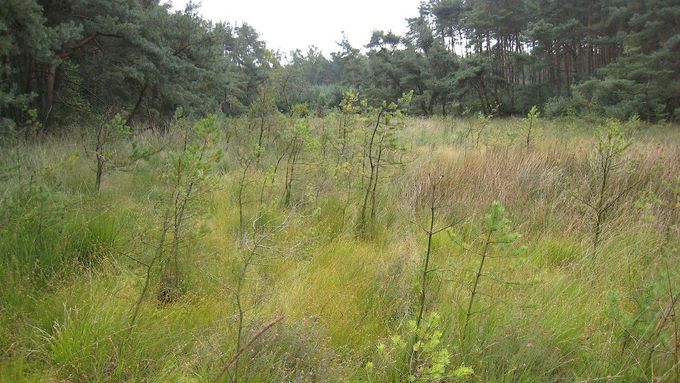The moor was heavily encroached before the action started. © Gerrit Bremer, Nature Conservation Station Wildenrath
download picturemain content
Project of the month
#12/2019
Optimization of transition mires and quaking bogs
Restoration of moorland areas and creation of small waterbodies in the SAC ‘Meinweg mit Ritzroder Dünen‘
The nature reserve ‘Meinweg‘ in the district of Heinsberg (HS-016) forms an ecological unit with the nature reserve ‘Luesekamp and Boschbeek’ (VIE-005) in the district of Viersen and the adjacent Dutch national park ‘De Meinweg’ in the province of Limburg. For the most part, it is congruent with the SAC ‘Meinweg mit Ritzroder Dünen’ (DE-4802-302). The ‘Meinweg’ is a closed forest area in which heath ponds, transitional mires and wet heaths have formed into depressions and dune valleys. Due to the species inventory and low-nutrient character, its moors are of great value for the natural region ‘Lower Rhine Valley and Cologne Lowland’. Because of the diversity of natural development stages – from open heath ponds and various forms of transitional mires to wet heaths – and their predominantly good conservation status, this area occupies a prominent place among comparable areas in this natural region.
The areas processed from December 2018 to March 2019 in the framework of the LIFE Integrated Project ‘Atlantic Region DE’ are located in the core area of the nature reserve in the district of Heinsberg on the border to the district of Viersen between Dahlheim-Rödgen and (Ober)-Niederkrüchten. The area is privately owned by the ‘Behlau‘sche Gutsverwaltung‘. The measures were carried out in close cooperation with the land owner and in cooperation with the nature conservation station ‘Haus Wildenrath’ and the Lower Nature Conservation Authority of the district of Heinsberg. The aim was to optimize the moorland and to upgrade the habitat types ‘transition mires and quaking bogs’ (7140) and ‘natural dystrophic lakes and ponds’ (3160). First of all, shrubs were removed from a total area of 3.3 hectares – in particular pines in the marginal area – thus creating a buffer strip. In addition, the moorlands were cleared of wood. By the removal of common rush (Juncus effusus) populations which are not typical for this site, several small waterbodies and bog ponds were created. Thanks to the private initiative of the owner, a multiple of the originally intended (rush) area could be processed. Striking single trees or groups of trees remained unaffected.
Due to an improved water regime and lower evaporation, a significant optimization of the sites with transition mires and quaking bogs is to be expected. By removing the vegetation which is not typical for this site, a strengthening of the moorland vegetation and, consequently, a reactivation of the function of the bog, i.e. long term as storage of carbon dioxide, should take place. With the habitat optimization, also the resettlement of the moor frog (Rana arvalis) is pursued. In addition, a strengthening of the populations of the woodlark (Lullula arborea) and the stonechat (Saxicola rubicola) is expected.
Related Topics
additional information
Contact
Further Links
- SAC ‘Meinweg mit Ritzroder Dünen’ – Landesamt für Natur, Umwelt und Verbraucherschutz Nordrhein-Westfalen (in German) (external link opens in a new window)
- National Park Region MeinWeg - Zweckverband Deutsch-Niederländischer Naturpark Maas-Schwalm-Nette (in German) (external link opens in a new window)
- Nature Conservation Station Wildenrath (in German) (external link opens in a new window)
- Department for Environment and Traffic Planning of the District of Heinsberg, Division (in German) (external link opens in a new window)





